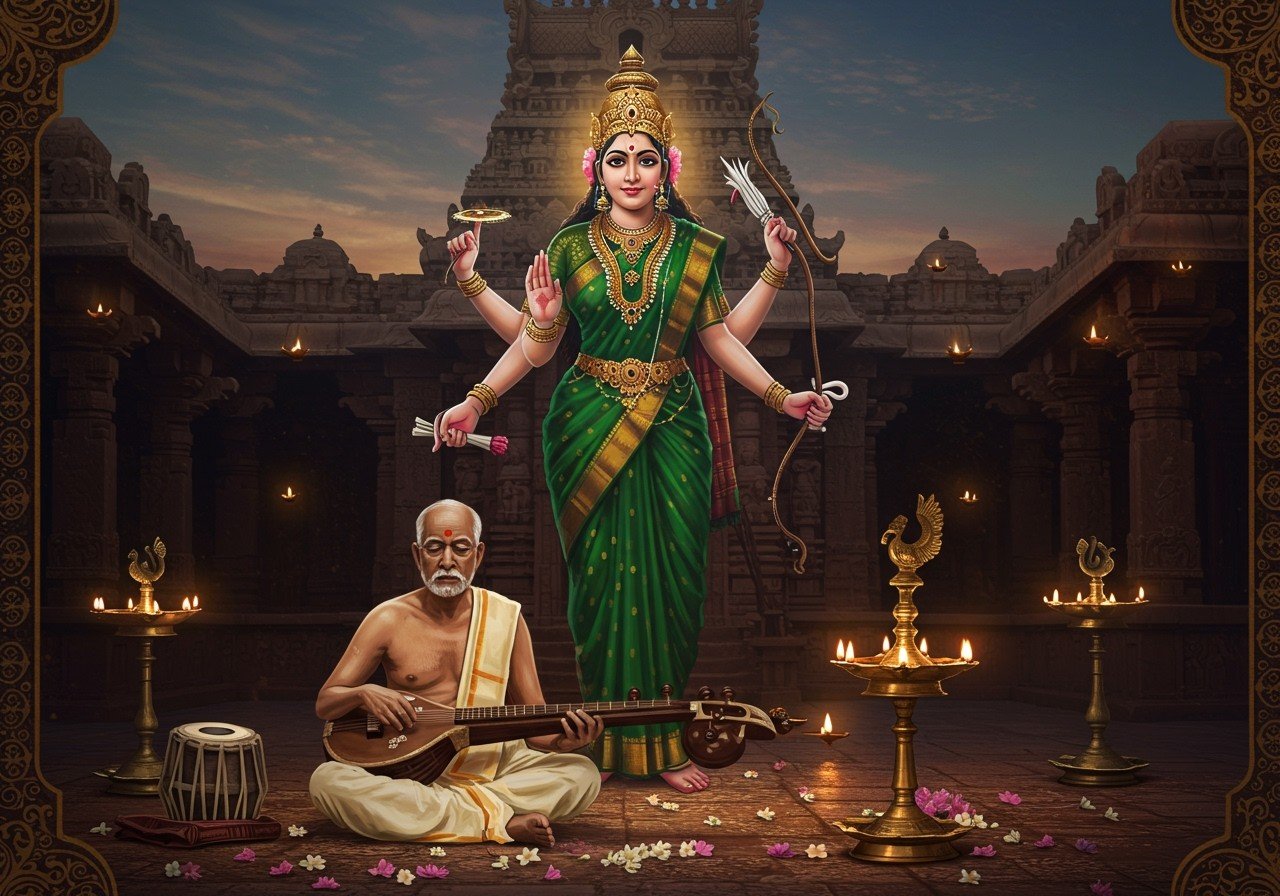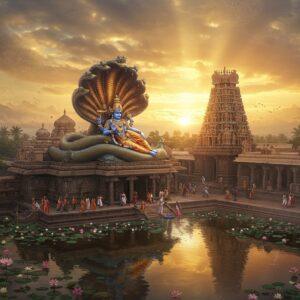
Syama Sastri (1762-1827), a revered figure in Carnatic music, holds a prominent place as one of the Trinity. His compositions, known as kritis, are not merely songs but spiritual expressions that continue to resonate with devotion and artistic brilliance.
Devotional Heart of Syama Sastri’s Music
Syama Sastri’s music is deeply imbued with devotion, often directed towards Hindu deities, particularly Goddess Kamakshi. His lyrics, characterized by simplicity and a child-like plea, express pure love and surrender to the divine. The careful selection of ragas enhances the emotional and spiritual depth, transforming his kritis into acts of worship. The themes of bhakti (devotion) and sharanagati (surrender) are central to his works, inviting listeners into a world of profound spiritual experience. Explore the spiritual significance of temples and sacred sites for a deeper understanding of devotion in Indian culture.
The Divine Connection in Syama Sastri’s Kritis
Sastri’s profound connection with Hindu deities, especially Goddess Kamakshi, is palpable in his kritis. Each composition feels like a personal offering, bridging the gap between the human and the divine. His dedication transcends mere artistry; it embodies a form of worship deeply rooted in temple traditions. The symbolism within his songs evokes vivid imagery of divine attributes and mythological narratives, bringing these ancient stories to life through melody and rhythm. This divine connection offers a pathway to spiritual enlightenment, inviting listeners to experience the presence of the divine. You can find a range of Radha-Krishna bigrahas and Shiva Lingams at poojn.in to enhance your personal devotional practice.
Syama Sastri’s Enduring Legacy in Carnatic Music
Syama Sastri’s contribution to Carnatic music is profound. His distinctive compositional style masterfully blends complex rhythms with lyrical beauty, creating a rich tapestry of sound that reflects South India’s cultural heritage. His works demonstrate a deep understanding of music as both an art form and a spiritual practice. He pioneered innovative ways of integrating rhythm and melody, inspiring generations of musicians. His influence transcends mere musical notes, elevating Carnatic music into a powerful form of spiritual expression and cultural identity. Discover more about the rich tapestry of Indian traditions through articles on Odisha’s festivals and the sacred power of water.
Deciphering the Profound Meaning of Syama Sastri’s Kritis
Syama Sastri’s kritis delve into profound themes of divine love and spiritual longing. His lyrics, rich in metaphor and allegory, act as gateways to deeper spiritual truths. They embark on an emotional journey, guiding both performer and listener towards inner peace and divine connection. Performing his kritis requires not only musical skill but also a deep understanding of their inherent spiritual depth. Each note and word carries significant weight, fostering a shared space of contemplation and devotion. Enhance your understanding of spiritual texts with a Bengali version of the Srimad Bhagavad Gita available at poojn.in.
Syama Sastri’s Impact on Cultural Identity
Syama Sastri’s music has profoundly shaped the cultural identity and spiritual consciousness of South India. His compositions preserve traditional values and religious practices, serving as spiritual companions during rituals and ceremonies. His music fosters a sense of community and shared heritage, reminding us of the enduring power of devotion and the beauty of cultural traditions. Even today, his kritis are revered as timeless expressions of devotion, continuing to inspire and unite communities. Poojn.in offers a variety of clay diyas, sacred threads, and other puja essentials to enhance your spiritual practices.
Poojn.in: Supporting Your Spiritual Journey with Syama Sastri’s Music
Poojn.in offers a curated selection of items to enhance your experience of Syama Sastri’s music:
- Musical Instruments: Pure brass bells and ghanti for keeping rhythm, wooden manjiras for accompaniment, and traditional tambura for maintaining shruti. These high-quality instruments are crafted to enhance the devotional experience.
- Worship Essentials: Silver and brass deepam lamps for evening performances, pure cotton asanas for comfortable seating during practice, and copper and brass sambranis for creating a sacred atmosphere. These essentials help create a serene and spiritual environment.
- Books and Guides: Printed collections of Syama Sastri’s compositions, notated music books with lyrics and meanings, and guides on proper pronunciation of Sanskrit verses. Deepen your understanding and appreciation of Sastri’s work.
To purchase these and other items, or for expert guidance:
- Call: 03369029784
- WhatsApp: 9476142738
- Visit: www.poojn.in
All products are quality-checked and sourced from authentic manufacturers, ensuring traditional standards. We offer pan-India delivery with secure packaging to protect delicate items.
Conclusion
Syama Sastri’s compositions are more than just music; they are spiritual experiences. His profound devotion, especially towards Goddess Kamakshi, shines through each kriti, enriching the Carnatic tradition and inspiring generations. His music continues to resonate with listeners, fostering a sense of community and cultural pride. Syama Sastri’s kritis are invitations to embark on a spiritual journey, connecting us with a rich heritage of devotion, artistry, and deep cultural roots.
FAQs on Syama Sastri and His Compositions
What makes Syama Sastri’s music so devotional? His compositions are imbued with a deep sense of reverence and love for Hindu deities, creating an atmosphere of spiritual connection. His lyrics often express a child-like yearning for the divine, enhancing the emotional depth of his works.
How are his compositions connected to Hindu deities? Syama Sastri’s kritis frequently feature lyrics dedicated to Hindu deities, especially Goddess Kamakshi. They serve as expressions of devotion, praise, and surrender, playing a significant role in religious practices.
What is Syama Sastri’s role in the Carnatic music tradition? He stands as one of the Trinity of Carnatic music, his unique compositional style influencing generations of musicians. His innovative approach to integrating rhythm and melody has left an indelible mark on the tradition.
What is the spiritual significance of his kritis? Syama Sastri’s kritis are considered spiritually meaningful because they blend poetic lyrics with heartfelt devotion. This creates an immersive experience that transcends mere entertainment, uplifting the listener’s mind and spirit.
How are Syama Sastri’s kritis typically performed? They are often performed in concerts, religious ceremonies, and other gatherings. Musicians and vocalists interpret the intricate ragas and talas, enhancing the spiritual atmosphere of these occasions.


